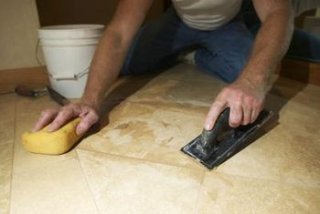
 A wet cleansing sponge is handy for touch-ups for the grouting procedure.
A wet cleansing sponge is handy for touch-ups for the grouting procedure.
Tiny or slim grout bones in many cases are utilized when setting up tiny tiles, particularly on wall space, and some contractors use thin joints with natural rock. Small bones may seem to offer less accessibility for water to seep through, but badly grouted thin joints can result in more moisture penetration than well-grouted broader bones. Grouting small bones is the identical procedure as grouting larger bones. The process is mainly the physical exercies of pushing the grout to the small areas. Any atmosphere pockets left in the bones produce weak spots where in fact the grout can crack or crumble.
Wear eye protection and a throwaway dirt mask to protect against airborne grout particles.
Combine unsanded tile grout with water in a container, following the grout manufacturer’s combining guidelines. For tiny batches, you'll blend the grout with a wooden paint stir stick. Blending big batches is much simpler if you use a paint-mixing paddle with an electrical exercise. Just fasten the paddle towards exercise and mix the material as if you are employing a kitchen hand blender. Don't mix over you'll use within about a half hour.
Allow the grout rest when you look at the bucket - an activity known as slaking - for as long as the maker suggests. The grout is preparing to make use of once the persistence is somewhat rigid, maybe not runny like pancake batter. Thin grout now is easier to make into thin grout bones, nonetheless it shrinks overly as a result of the high-water content, ultimately causing sunken or concave joints, cracks and failed grout.
Scoop up grout from container onto the edge of a foam-backed grout float. A grout float is a rectangular, paddle-type device with a handle ahead and a flexible foam finish regarding straight back. The foam safeguards the tiles from scratches.
Distribute the wet grout across a tiny part of tile.
Drag the edge of the float across the tiles in as many various directions as possible, forcing the grout in to the bones. Pull the side of the float back-and-forth from remaining to right, up and as well as in diagonal instructions through to the bones are packed complete.
Clean down extra grout from surface of this tiles that you simply grouted utilising the edge of the float, after that move to the second part of tiles.
Apply even more grout and work it to the bones as before through to the tiles tend to be totally grouted.
Let the grout to sleep for ten minutes.
Soak a sizable sponge with liquid and press from excess. Wipe the sponge across the tiles to remove residual grout, but don’t disturb the grout in the joints.
Wait until a light-colored, chalky or powdery residue kinds over the tiles, then wipe it well with a clear, dry cloth. At this point, the grout continues to be maybe not completely dry. Use caution not to inadvertently dislodge the grout when you look at the joints.
Issues Will Need
- Eye defense
- Disposable dust mask
- Unsanded tile grout
- Container
- Paint stir stick or power exercise with paint-mixing paddle
- Grout float
- Big sponge
- Towels










